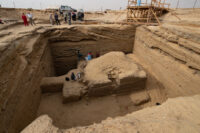 The owner of the largest-ever cachette of Egyptian embalming materials has been identified as the military commander of Egypt’s foreign troops in the late 26th/early 27th Dynasty, (early 6th century B.C.). His name was Wahibre-mery-Neith, and the most important title recorded on his funerary inscriptions was “Commander of Foreign Mercenaries.” That made him responsible for all the muscle Egypt hired, mostly from the Greek islands and Asia Minor, in the desperate attempt to fend off the rising power of Achaemenid Persia.
The owner of the largest-ever cachette of Egyptian embalming materials has been identified as the military commander of Egypt’s foreign troops in the late 26th/early 27th Dynasty, (early 6th century B.C.). His name was Wahibre-mery-Neith, and the most important title recorded on his funerary inscriptions was “Commander of Foreign Mercenaries.” That made him responsible for all the muscle Egypt hired, mostly from the Greek islands and Asia Minor, in the desperate attempt to fend off the rising power of Achaemenid Persia.
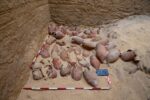 The embalming cachette with more than 370 pottery jars full of mummification materials, the largest ever found in Egypt, was discovered by the Czech mission last year. The materials were all ritually buried after they were used to mummify Wahibre-mery-Neit. His name was inscribed on the canopic jars, but not his rank or profession. It was clear from the sheer scale of the cachette that he was someone of very high rank, one of the most important dignitaries of the Late Period.
The embalming cachette with more than 370 pottery jars full of mummification materials, the largest ever found in Egypt, was discovered by the Czech mission last year. The materials were all ritually buried after they were used to mummify Wahibre-mery-Neit. His name was inscribed on the canopic jars, but not his rank or profession. It was clear from the sheer scale of the cachette that he was someone of very high rank, one of the most important dignitaries of the Late Period.
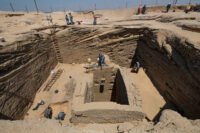 The shaft tomb next to the cachette was excavated this spring by the Czech archaeological mission from Charles University. The inscriptions in the burial shaft confirm that the tomb belonged to Wahibre-mery-Neith, whose name and the name of his mother Lady Irturu appear on the canopic jars in the cachette.
The shaft tomb next to the cachette was excavated this spring by the Czech archaeological mission from Charles University. The inscriptions in the burial shaft confirm that the tomb belonged to Wahibre-mery-Neith, whose name and the name of his mother Lady Irturu appear on the canopic jars in the cachette.
The main well of the tomb is 20 feet deep and 46 feet square. It is divided into sections by narrow bridges that were cut out of the bedrock. A smaller, deeper shaft (52 feet deep, 21 by 11 feet wide) descends down the center of the main well. There is no other shaft tomb in Egypt with this exact layout.
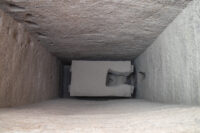 At the bottom of the deeper well are two sarcophagi nested inside each other. The outer sarcophagus is composed of two massive slabs of white limestone. The inner sarcophagus is anthropoid in shape and carved out of heavy black basalt. It is inscribed with spells from chapter 72 of the Book of the Dead which describe the resurrection of the deceased and his journey to the afterlife.
At the bottom of the deeper well are two sarcophagi nested inside each other. The outer sarcophagus is composed of two massive slabs of white limestone. The inner sarcophagus is anthropoid in shape and carved out of heavy black basalt. It is inscribed with spells from chapter 72 of the Book of the Dead which describe the resurrection of the deceased and his journey to the afterlife.
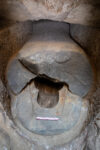 Looted in antiquity, the inner sarcophagus contained no human remains and very few objects. Only a scarab and a small headrest amulet were found inside the coffin. Looters broke into the outer sarcophagus and smashed the head area of the inner sarcophagus to steal valuables buried with the deceased. Two Coptic vessels found in the main shaft indicate the looting likely took place in the 4th or 5th century A.D.
Looted in antiquity, the inner sarcophagus contained no human remains and very few objects. Only a scarab and a small headrest amulet were found inside the coffin. Looters broke into the outer sarcophagus and smashed the head area of the inner sarcophagus to steal valuables buried with the deceased. Two Coptic vessels found in the main shaft indicate the looting likely took place in the 4th or 5th century A.D.
The double sarcophagus was situated directly on a filling of sand at the bottom of the burial shaft. Within the shaft, at the western and eastern sides of the sarcophagus, rather sparse burial equipment has originally
been placed. At the east, several items were excavated intact and in situ: two wooden boxes with altogether 402 faience shabtis (servant figures who were to undertake labour instead of the owner in the afterlife), two uninscribed alabaster canopic jars, a faience model of an offering table, ten model cups and a limestone ostracon inscribed with religious texts written in black ink and hieratic script. Due to the limited space, the author of the text decided to cover the ostracon with brief excerpts from the Book of the Dead spells that also formed parts of the ritual of transfiguration and thus guarantying an undisturbed afterlife existence of the owner. […]
Although the archaeological excavation of the burial of Wahibre-mery-Neith did not offer many excavated objects or an elaborate funerary equipment, it is unique and important, as it offers new insights into the troubled period of the beginning of Persian dominion in Egypt. In combination with outcomes of the ongoing research on the owner’s embalming deposit, a picture of Wahibre-mery-Neith’s life, family background and professional career
starts to emerge. He most probably died very unexpectedly, when his tomb and burial equipment were still unfinished. Thus, both the layout of his tomb and its contents provide very valuable information on the importance and meaning of individual parts of the burial equipment and tomb decoration. It also shows us how the ancient Egyptian adapted the material culture of their religious beliefs under difficult circumstances and in times of crisis when the indigenous character of ancient Egyptian civilisation started to vanish.